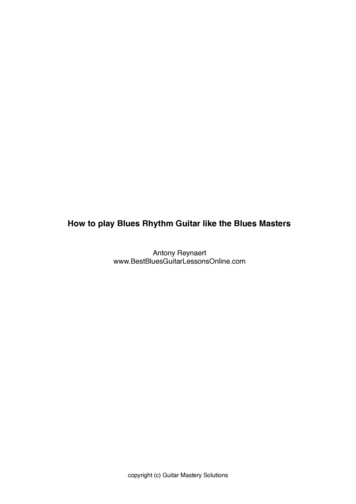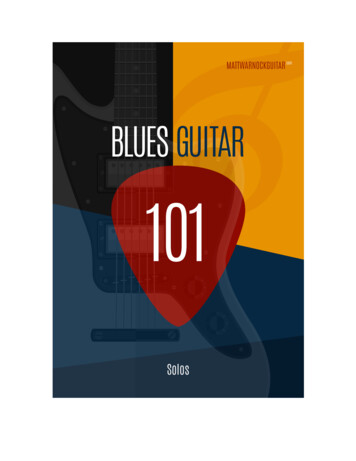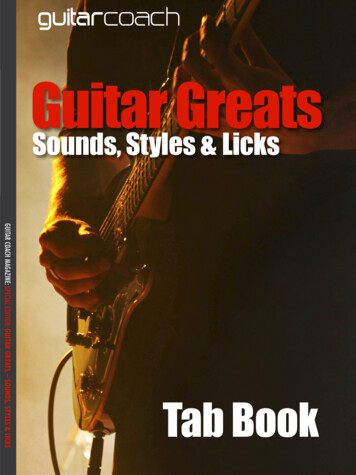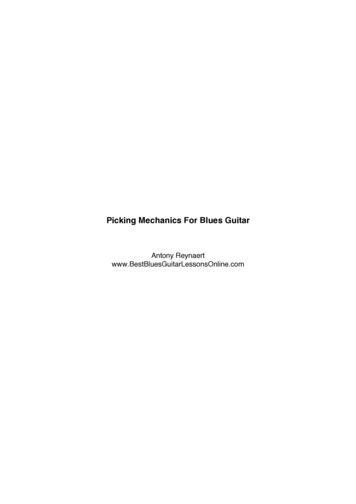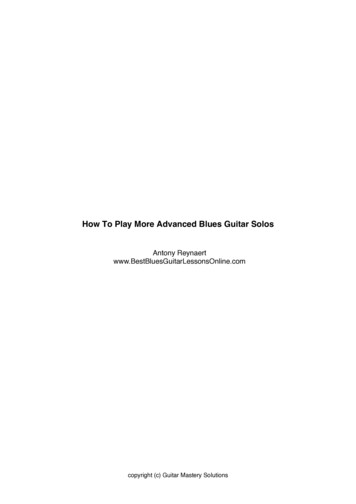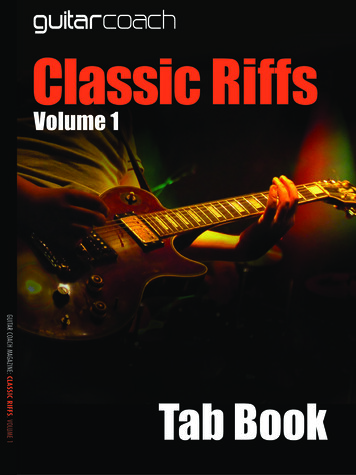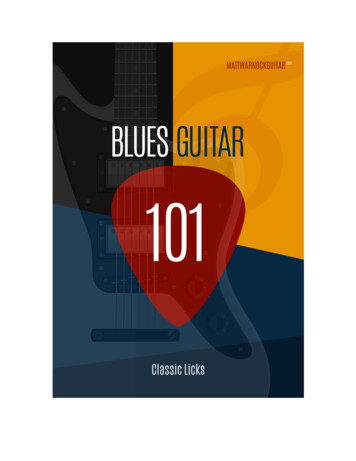
Transcription
Blues Guitar 101 – Classic LicksEssential Blues Guitar Licks and PhrasesWritten By: Matthew WarnockAudio By: Jack TaylorPublished By: Guitar for Life LLCCopyright 2018 Guitar for Life LLCmattwarnockguitar.com2
Table of ContentsGlossary of TermsHow to Use This eBookHow to Practice Blues LicksIntroduction to Blues ScalesIntroduction to Blues ArpeggiosMinor Blues Scale LicksMajor Blues Scale LicksRepeating LicksAlbert King LicksAlbert Collins LicksB.B. King LicksBuddy Guy LicksJoe Bonamassa LicksMuddy Waters LicksStevie Ray Vaughan LicksBlues Rock LicksJazz Blues LicksBlues Guitar SolosAbout the Authormattwarnockguitar.com3
Glossary of TermsMusic has a language all its own. To help you understand the material inthis book, here are common musical terms and definitions.Arpeggio: The notes of a chord played as single notes, directly outlininga chord in your solos.Chromatic: Notes or chords that are outside the given key or diatonicprogression. Used to create tension and interest in blues songs.Diatonic: Notes or chords that are found within the given key ordiatonic chord progression. Used to resolve chromatic tensions sounds.Double Stop: Two notes played at once on the guitar.Form: Term used to describe the length of a song. For example, blues isa 12-bar form. Popular music often uses the AABA form, etc.Lick: Short musical idea. Also called a riff, line, or phrase.Riff: Term used to describe a short musical idea on guitar, can bemelodic or harmonic. Also described as a lick, groove, line, or phrase.Scale: The notes of a key played together as a group, such as C majorscale, D minor scale, A minor blues scale, etc.Tonic: Describes the root note of the key you’re in, or the resolutionchord of the key you’re in. If you’re in the key of C, the tonic note is C,and the tonic chord is C major.Turnaround: The section of a song that uses single notes or chords toturn the song back around to the tonic chord, or to the top of the form.mattwarnockguitar.com4
How to Use This eBookWelcome to Blues Guitar 101 – Classic Licks. It’s great to have you here!In this eBook, you learn everything you need to understand, play, andbuild classic blues licks.You start off by learning how to practice each lick in this book, beforediving into the licks themselves, and finally learning full blues solos.The goal of this eBook is to open your ears, mind, and hands to thesounds that make up the classic blues vocabulary.Each of these licks has been chosen because it uses essential concepts,scales, arpeggios, and other blues devices.Start by learning the licks as written, then experiment with them in yoursolos, and finally create your own licks using the same concepts.By the time you finish this eBook, you’ll be able play dozens of classicblues guitar licks in many different keys.And, more importantly, you’ll be able to create your own classicsounding blues licks in the practice room and on the bandstand.If you’re new to blues guitar soloing, start at the beginning of this eBookand work down from there.If you’re more experienced, jump around to find the licks you want tostudy and work the eBook that way.There’s no right or wrong way to use this eBook, as long as you applythe licks and concepts to your own blues guitar solos.So, grab your guitar, crank up your amp, and have fun learning essentialblues guitar licks!mattwarnockguitar.com5
How to Practice Blues LicksBefore you learn any of the licks in this eBook, take a minute to learnhow to practice these licks in your studies.Learning a lick is one thing, but being able to use that lick in your solos,and making it your own, takes a few more steps.Check out these three steps to learning any blues guitar lick to get themost out of your time in the practice room.Licks in Multiple KeysThe first step to learning any blues lick is to get it under your fingers inthe key you find it in.As an example, the lick in bar 1 below is in the key of A, over an A7chord, so you start with that key first.When ready, take that lick and play it in other keys around the fretboardto expand the line in your playing.To do this, look for clues as to how the lick is built and where it sitswithin the original key.In this example, the second note of the lick is the root, A over A7 in bar1, and is built from the Am blues scale.This means that if you slide up to the Dm blues scale, and the secondnote of the lick is D, you’re now playing the lick in D, over D7.Here are a few keys to use as an example when learning how to movelicks around to different keys in your studies.mattwarnockguitar.com6
Licks in Multiple PositionsThe next step is to take any lick you learn and play it in differentpositions on the guitar.This means starting the lick on different strings, as you see in theexample below.Though this is tough to do, it allows you to access any lick you learn inany area of the fretboard in your solos.This approach increases your vocabulary and opens up your fretboardat the same time.mattwarnockguitar.com7
One Lick Over Entire Blues ProgressionThe last way to practice licks is to play them over every chord in a bluesprogression, as you can see in this example.Start by playing the licks exactly as you learned them over each chord inone position.Then, play the licks in different positions over the chords, and finally beable to alter the licks as you make them your own in your solos.This last exercise is tough to do.But, if you worked on the previous exercises in this section, you’re readyto tackle the full blues progression with any lick you learn.mattwarnockguitar.com8
mattwarnockguitar.com9
Major Blues Scale LicksYou now move on to learning licks from the major blues scale.As a reminder, these licks are only played over one chord at a time,compared to every chord in a blues with the minor blues scale.This means that if you have a G major blues scale lick, you use that overa G7 chord in a blues solo.Then, if you want to play that lick over C7, you have to move it to a Cmajor blues scale position.This is tough to do when first learning how to apply major blues scalesto your solos.But, not to worry, with a little focused practice you can add these licks,and the major blues scale in general, to your solos with confidence.Apart from learning these licks, you also explore various ways to addrepetition and development to your solos.Both of these concepts help you develop a mature sense of melody andphrasing with this, or any, scale in your solos.The first line is a major blues scale phrase that you hear in jazz, blues,country, swing, and other musical genres.Because it’s such a popular lick across genres, it’s first in this chapter,and is essential to learn and add to your solos.If you learn only one major blues scale lick, this is it.mattwarnockguitar.com10
Audio Example 6Here, you play a major blues idea in bar one, then repeat the same basicidea in bar two but one a different rhythm and one added note.This type of melodic development helps you extend your ideas withoutrepeating them directly.By slightly altering the rhythm in bar two, you’re able to repeat the firstphrase and expand it at the same time.This allows you to cover more ground in your solos with less material.After learning this line, work that concept into your playing as youdevelop your ability to expand repeated phrases in your solos.Audio Example 7mattwarnockguitar.com11
Here, you play the same idea in two different octaves, giving you theoption to play either or both in your solos.Repeating ideas in different octaves adds a sense of melodicdevelopment in your playing.It also allows you to extend your solos without playing anything new,and not sounding repetitive in the process.After you learn this line, work on this concept further as you repeatlines in different octaves in your solos.Audio Example 8Here, you bend up from the 2nd note to the b3, the blues note in themajor blues scale, as well as repeat the line in both bars.Often you feel like everything you play has to be new and different thanwhat you played before.But, repeating ideas in your solos helps establish a connection with thelistener, as well as develops a sense of melodic phrasing in your solos.Work this line as written, then take this concept to your own solos asyou repeat ideas to solidify them in your playing.mattwarnockguitar.com12
Audio Example 9In this major blues lick you play the same start to both bars, but enddifferently in bar 1 compared to bar 2.This is a common blues soloing technique, and one you can use toextend your ideas, as you don’t need two full ideas for two bars.If you dig this concept, explore it further in your own playing overvarious blues chord progressions.Audio Example 10mattwarnockguitar.com13
Albert King LicksThough at one time he claimed to be B.B. King’s half brother, and atanother time was called B.B.’s dad, Albert King has no relation to B.B.What does bind the two King’s together is their ability to creatememorable blues guitar solos and their command of the guitar.Playing a right-handed flying V guitar flipped upside down, as he wasleft-handed, King brought a style all his own to the blues genre.In this chapter you learn 5 classic King inspired licks that you canpractice and add to your own blues guitar solos.The first line is based on the Dm blues scale and contains a bend andpull-off, both essential to the success of this line.Lastly, there’s a shake at the top of the bend that brings a vocal qualityto that note.Make sure to bend in tune and then give that note a good shake to createthe vocal feeling to start the line.Audio Example 16mattwarnockguitar.com14
The first two notes of this King inspired line are called a “rake,” whereyou hit the 3rd and 2nd strings but don’t sound those notes.Instead, you mute the strings with your fretting hand to give those twonotes a percussive rather than melodic sound to start the line.Rakes are a great way to create new textures and sounds in your solos,and one that many great blues guitarists like King used in their playing.Audio Example 17In this lick, you mix both the Dm blues scale as well as the major 3rdinterval, F# at the start of the last bar.This note brings an arpeggio sound to this lick, directly outlining thechord as well as being bluesy at the same time.Albert King knew the power of a well placed arpeggio note, such as yousee here, and so it’s worth taking this concept further in your playing.mattwarnockguitar.com15
Audio Example 18This lick features 3 large bends, full step and 1.5 step bends, whichcreate a very cool sound, but make the line tough to play.Go slow, work those bends separately, and when can nail those bendson their own, bring the lick together as a whole.Big bends, such as King often used, add an emotional quality to yourplaying, but only if they’re in tune.If you nail a bend, it’s the best feeling in the world.But, if you miss a bend, it can derail your whole solo.Work these, and other bends, until you can bend them in tune and yourplaying will hit the next level before you know it.mattwarnockguitar.com16
Audio Example 19In this King lick you mix different rhythms and picking techniques asyou outline a D7 chord with the D minor blues scale.Go slow with this line, make sure the rhythm is tight, and then makesure the bends are solid as well.Those two items are both the key to this line and the parts that, if notplayed accurately, cause the lick to fall flat.Audio Example 20mattwarnockguitar.com17
Joe Bonamassa Licks Muddy Waters Licks Stevie Ray Vaughan Licks Blues Rock Licks Jazz Blues Licks Blues Guitar Solos About the Author mattwarnockguitar.com 4 Glossary of Terms Music has a language all its own. To help you understand the material in this book, here are common musical terms and definitions. Arpeggio: The notes of a chord played as single notes, directly outlining a chord in your .

